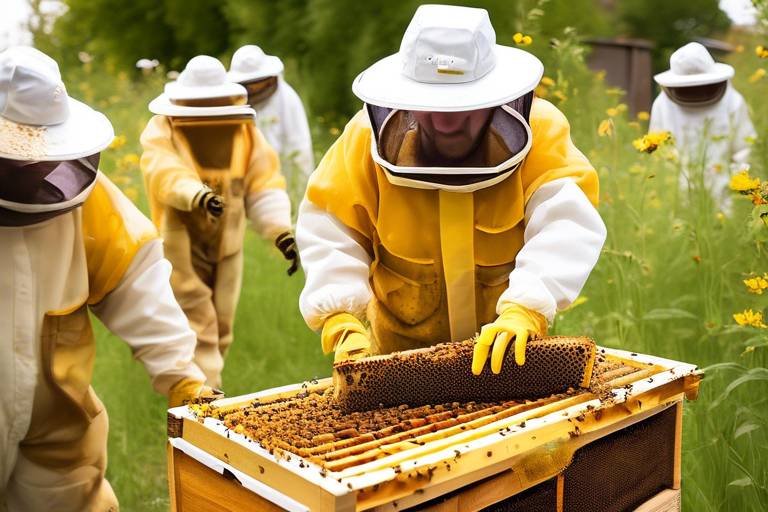How to Grow Your Own Herbs Indoors
Growing your own herbs indoors can be a rewarding and enriching experience. Not only does it provide you with a fresh and convenient source of flavorful herbs, but it also adds a touch of greenery and life to your living space. Imagine having a mini herb garden right in your kitchen, where you can easily snip off a few leaves of basil or mint to enhance your culinary creations. With the right knowledge and techniques, you can successfully cultivate a variety of herbs indoors, regardless of the season or weather conditions outside.
When it comes to choosing the right herbs for indoor cultivation, consider factors such as your personal preferences, available space, and lighting conditions. Some popular herbs that thrive indoors include basil, mint, parsley, chives, and thyme. Each herb has its own unique requirements in terms of sunlight, water, and soil, so it's essential to select herbs that align with your indoor environment and gardening capabilities.
Setting up your indoor herb garden involves selecting suitable containers, preparing the right soil mix, and establishing a proper watering schedule. Container options range from traditional pots to hanging baskets and vertical planters, allowing you to maximize space and create a visually appealing herb display. The soil mix should be well-draining and nutrient-rich to support healthy herb growth, while watering frequency should be adjusted based on the specific needs of each herb.
Lighting is a crucial factor in the success of indoor herb gardening. Most herbs require at least 6-8 hours of sunlight per day to thrive, so it's important to place your herb garden near a sunny window or supplement with artificial grow lights. Adequate lighting not only promotes robust growth but also enhances the flavor and aroma of your herbs.
Proper pruning and harvesting techniques are essential for maintaining the health and productivity of your indoor herbs. Regular pruning helps to encourage bushier growth and prevent legginess, while harvesting herbs at the right time ensures optimal flavor and freshness. By mastering the art of pruning and harvesting, you can enjoy a continuous supply of herbs for your culinary adventures.
Unfortunately, indoor herbs are not immune to pests and diseases, so it's important to be vigilant and proactive in preventing and addressing these issues. Common pests such as aphids, spider mites, and whiteflies can damage herb plants, while diseases like powdery mildew and root rot can hinder growth. Implementing good plant hygiene practices and using organic pest control methods can help safeguard your indoor herb garden.
Experimenting with different herb combinations is a fun and creative way to elevate your indoor herb garden. By mixing and matching herbs with complementary flavors and aromas, you can create unique blends for cooking, teas, and infusions. Consider pairing herbs like rosemary and thyme for savory dishes or mint and lemon balm for refreshing beverages. The possibilities are endless when it comes to creating herb combinations that tantalize your taste buds.

Choosing the Right Herbs
When it comes to choosing the right herbs to grow indoors, it's essential to consider your personal preferences, available space, and lighting conditions. Each herb has its own unique requirements for successful cultivation, so selecting the right ones can make a significant difference in the success of your indoor herb garden.
For beginners, starting with easy-to-grow herbs like basil, mint, and parsley can be a great way to build confidence and experience in indoor gardening. These herbs are resilient and forgiving, making them ideal choices for those new to herb cultivation.
If you have limited space, consider compact herbs like chives, thyme, and oregano that can thrive in smaller containers or vertical gardens. These herbs are versatile and can be used in a variety of culinary dishes, adding flavor and aroma to your meals.
When it comes to lighting conditions, some herbs require full sun, while others can tolerate partial shade. Herbs like rosemary, sage, and lavender prefer bright light, so placing them near a sunny window or under grow lights can help them thrive indoors.
Consider your culinary preferences when choosing herbs for your indoor garden. If you love Italian cuisine, herbs like basil, oregano, and thyme are essential for creating authentic flavors. For tea enthusiasts, growing herbs like chamomile, mint, and lemon balm can provide a soothing and aromatic experience.

Setting Up Your Indoor Herb Garden
Setting up your indoor herb garden is an exciting and rewarding endeavor that can bring fresh flavors and aromas into your home throughout the year. When creating your indoor herb garden, it's essential to consider various factors such as container options, soil mixes, and watering schedules to ensure the success of your herbs.
Firstly, choosing the right containers for your herbs is crucial. Opt for containers that have drainage holes to prevent waterlogging, which can lead to root rot. Additionally, consider the size of the containers based on the growth habits of the herbs you plan to cultivate. Some herbs, like basil, require more space to spread out, while others, such as thyme, can thrive in smaller pots.
When it comes to soil mixes, using a well-draining potting mix specifically designed for herbs is recommended. This type of soil ensures proper aeration and drainage, which are essential for healthy root development. You can also enrich the soil with organic matter like compost to provide additional nutrients for your herbs.
Establishing a consistent watering schedule is vital for the well-being of your indoor herbs. Overwatering can lead to root rot, while underwatering can cause the herbs to wilt and dry out. To determine when to water your herbs, check the moisture level of the soil using your finger. Water thoroughly when the top inch of soil feels dry to the touch.
Placement of your indoor herb garden is another key aspect to consider. Most herbs require at least 6-8 hours of sunlight per day to thrive. If natural sunlight is limited in your home, consider supplementing with artificial grow lights to provide the necessary light intensity for your herbs.
Lastly, regular maintenance and care are essential for the success of your indoor herb garden. Monitor your herbs for any signs of pests or diseases and take prompt action to prevent their spread. Pruning your herbs regularly can help promote bushier growth and increase yields for harvesting.

Lighting Requirements
When it comes to growing herbs indoors, lighting plays a crucial role in ensuring their health and vitality. Herbs, just like any other plant, require sufficient light to carry out photosynthesis and thrive. While natural sunlight is the ideal source of light for herbs, it may not always be feasible to provide them with direct sunlight, especially in indoor settings.
For indoor herb gardens, one of the best alternatives to natural sunlight is using artificial grow lights. These lights are specifically designed to mimic the spectrum of sunlight needed for plant growth. When choosing grow lights for your indoor herbs, consider factors such as the light intensity, color spectrum, and duration of light exposure.
Placement of your herbs in relation to the light source is also crucial. Different herbs have varying light requirements, with some needing more direct light than others. Basil, for example, thrives in bright, indirect light, while rosemary prefers full sunlight. Understanding the specific lighting needs of each herb will help you position them accordingly for optimal growth.
It's important to monitor the light exposure your herbs receive daily. Rotate the pots regularly to ensure all sides of the plants receive equal light exposure and prevent them from leaning towards the light source. Remember that inadequate light can result in leggy, weak plants with poor flavor, so investing in proper lighting is essential for a successful indoor herb garden.

Watering and Humidity
When it comes to growing herbs indoors, proper watering and humidity levels are crucial for the health and vitality of your plants. Overwatering can lead to root rot and other issues, while underwatering can cause herbs to wilt and dry out. Finding the right balance is key to ensuring your indoor herb garden thrives.
One effective way to determine when your herbs need watering is by checking the moisture level of the soil. Stick your finger into the soil up to your first knuckle - if it feels dry to the touch, it's time to water. Different herbs have varying water requirements, so it's essential to understand the specific needs of each herb you are growing.
Humidity levels also play a significant role in the growth of indoor herbs. Most herbs prefer moderate humidity levels, so if your home is particularly dry, consider using a humidifier or placing a tray of water near your herb garden to increase moisture in the air. However, be cautious not to create too much humidity, as this can lead to mold and mildew issues.
When watering your herbs, it's essential to water at the base of the plant to avoid getting the leaves wet, which can promote fungal diseases. Using a watering can with a narrow spout can help target the water directly at the soil. Additionally, allowing excess water to drain out of the container is crucial to prevent waterlogged roots.
Creating a watering schedule based on the specific needs of your herbs can help maintain consistent moisture levels in the soil. Some herbs may require more frequent watering, while others prefer to dry out slightly between waterings. Observing the growth and behavior of your herbs can also provide valuable insights into their watering requirements.

Pruning and Harvesting
Pruning and harvesting are essential practices for maintaining a healthy and productive indoor herb garden. By regularly pruning your herbs, you can stimulate new growth, prevent legginess, and encourage bushier plants. When it comes to harvesting, timing is key to ensure the best flavor and aroma from your herbs.
One effective pruning technique is to pinch off the tips of the stems regularly. This helps to promote branching and prevents the herbs from becoming too tall and leggy. Additionally, removing any yellowing or dead leaves will help the plant focus its energy on producing new growth.
When harvesting your herbs, it's important to do so when the plant is actively growing but before it flowers. This is when the essential oils that give herbs their flavor are most concentrated. Use sharp scissors or pruning shears to cut the stems above a leaf node to encourage new growth.
Consider creating a harvesting schedule based on the growth rate of each herb. Some herbs, like basil, benefit from frequent harvesting to prevent flowering and encourage bushier growth. Others, such as rosemary, can be harvested less frequently but in larger quantities.
Remember to harvest only what you need, as fresh herbs have the best flavor. If you have an abundance of herbs, consider drying or freezing them for later use. Proper pruning and harvesting techniques will not only keep your indoor herb garden looking tidy but also ensure a continuous supply of fresh herbs for your culinary adventures.

Dealing with Common Pests and Diseases
Dealing with common pests and diseases is a crucial aspect of maintaining a healthy indoor herb garden. Pests such as aphids, spider mites, and whiteflies can quickly infest your herbs, causing damage to the plants if left unchecked. Additionally, diseases like powdery mildew and root rot can also impact the overall health of your herbs. It's essential to be proactive in identifying and addressing these issues to ensure the continued growth and vitality of your indoor herb garden.
One effective method of pest control is to regularly inspect your herbs for any signs of infestation. Look for yellowing leaves, sticky residue, or visible pests on the plant. If you notice any issues, isolate the affected herb to prevent the infestation from spreading to other plants. You can also introduce beneficial insects such as ladybugs or lacewings to help control pest populations naturally.
When it comes to diseases, proper plant hygiene is key to preventing their spread. Avoid overwatering your herbs, as excess moisture can create an environment conducive to fungal diseases. Ensure good air circulation around your plants and remove any dead or decaying foliage promptly. If you do encounter a disease outbreak, consider using natural remedies like neem oil or copper fungicides to treat the affected herbs.
Another preventive measure is to practice companion planting, where you grow certain herbs together that naturally repel pests or attract beneficial insects. For example, planting basil near tomatoes can help deter pests that commonly affect tomato plants. Additionally, creating a diverse herb garden with a variety of plant species can help reduce the risk of widespread pest or disease issues.
Remember, early detection and intervention are key to successfully managing pests and diseases in your indoor herb garden. By staying vigilant and implementing proactive strategies, you can enjoy a thriving herb garden year-round without the worry of common pests and diseases compromising your plants.

Organic Pest Control Methods
When it comes to protecting your indoor herb garden from pests, using organic pest control methods is not only effective but also environmentally friendly. These methods focus on natural solutions that help keep your herbs healthy without the need for harsh chemicals that can harm both the plants and the environment.
One popular organic pest control method is companion planting, which involves growing certain plants together to deter pests. For example, planting marigolds near your herbs can help repel insects due to their strong scent. This natural approach can create a balanced ecosystem in your indoor garden, reducing the risk of pest infestations.
Homemade sprays made from common household ingredients can also be effective in controlling pests. A simple mixture of water, dish soap, and a dash of cayenne pepper can act as a natural insect repellent. Regularly spraying this solution on your herbs can help keep pests at bay without the use of synthetic chemicals.
Furthermore, introducing beneficial insects like ladybugs or lacewings to your indoor herb garden can help control pest populations naturally. These insects feed on common herb pests such as aphids and caterpillars, providing a sustainable and chemical-free pest control solution.

Creating Herb Combinations
When it comes to creating herb combinations for your indoor garden, the possibilities are endless. Imagine your herb garden as a palette of flavors and scents, waiting to be mixed and matched to create culinary masterpieces. Just like a skilled chef combines various ingredients to craft a delicious dish, you can experiment with different herbs to elevate the taste and aroma of your favorite recipes.
One approach to creating herb combinations is to consider the flavor profiles of each herb. Some herbs, like basil and parsley, offer a fresh and bright taste, while others, such as rosemary and thyme, provide a more robust and earthy flavor. By understanding the unique characteristics of each herb, you can pair them together harmoniously to enhance the overall taste of your dishes.
Additionally, think about the cultural and regional cuisines that inspire you. Are you drawn to the vibrant flavors of Mediterranean cuisine or the spicy notes of Asian dishes? By incorporating herbs commonly used in these culinary traditions, you can create herb combinations that transport your taste buds to far-off lands.
Experimentation is key when it comes to creating herb combinations. Don't be afraid to mix unexpected herbs together or try out unconventional pairings. Who knows, you might stumble upon a winning combination that becomes your signature herb blend!
Consider the visual appeal of your herb combinations as well. Just as a colorful bouquet of flowers brightens up a room, a diverse array of herbs can add visual interest to your indoor garden. Mix and match herbs with different leaf shapes, colors, and textures to create a visually stunning display that is as beautiful as it is flavorful.
Remember, creating herb combinations is a fun and creative process that allows you to express your culinary personality. Whether you're whipping up a savory sauce, brewing a fragrant tea, or garnishing a salad, the herbs you choose can make all the difference in the final outcome. So, roll up your sleeves, grab your pruning shears, and start experimenting with herb combinations that will delight your senses and elevate your dishes to new heights!
Frequently Asked Questions
- What are the easiest herbs to grow indoors?
Growing herbs indoors can be a rewarding experience, especially with beginner-friendly herbs like basil, mint, and parsley. These herbs are resilient and adaptable to indoor environments, making them ideal choices for novice gardeners.
- How much light do indoor herbs need?
Most herbs require at least 6-8 hours of sunlight daily to thrive. If natural light is insufficient, supplemental grow lights can be used to provide the necessary light spectrum for healthy herb growth.
- How often should I water my indoor herbs?
Proper watering is crucial for the health of indoor herbs. Generally, herbs prefer slightly moist soil, so it's essential to check the soil moisture regularly and water when the top inch feels dry to the touch.
- What are some natural ways to control pests in indoor herb gardens?
There are several organic pest control methods for indoor herbs, including using companion plants like marigolds, neem oil sprays, and introducing beneficial insects like ladybugs. These natural solutions help protect your herbs without the use of harsh chemicals.



















